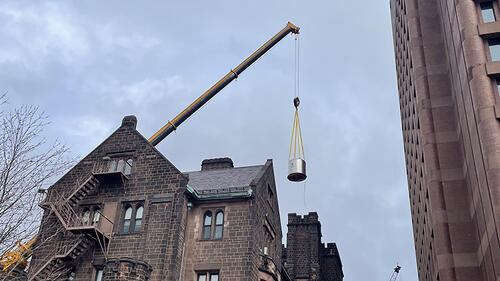
On Saturday, March 9, a team of researchers, technicians, and contractors was on campus to move a powerful (15.3 Tesla) superconducting magnet from professor Sean Barrett’s lab in the basement of Sloane Physics Laboratory (SPL) to Yale Wright Laboratory (Wright Lab). The magnet, including parts installed to secure it for transport, weighed 12,000 lbs.
The magnet will be the heart of the new Axion Longitudinal Plasma Haloscope (ALPHA) experiment, which will be located at Wright Lab. ALPHA will extend the search for a hypothetical dark matter candidate–a very low-mass particle called the axion—to a higher mass range than has been searched for previously.
ALPHA is funded by a partnership of The Gordon and Betty Moore Foundation, the Simons Foundation, the Alfred P. Sloan Foundation, and the John Templeton Foundation.
Reina Maruyama, professor of physics, deputy spokesperson of the ALPHA experiment, and a member of Wright Lab said, “I am excited we can do this experiment at Yale. I am grateful to Professor Barrett for offering to share this magnet with us, and Yale’s leadership and facilities teams for enabling this science. I am looking forward to turning on the magnet and starting to look for axions with this new instrument ALPHA.”
Karsten Heeger, Eugene Higgins Professor of Physics, director of Wright Lab, and a member of the Yale ALPHA team, said, ”We are excited to host the next step in the axion search for dark matter at Wright Lab.”
The move
According to Wright Lab research and development technician Frank Lopez, before Saturday’s move, contractors did preparatory work in SPL, such as removing a window of SPL, setting up stacked pieces of wood to safely secure an object at a height so a worker will not have to go under a suspended load, and installing the parts needed to protect the magnet during travel.
On the day of the move, Smedley Crane & Rigging handled the lifting from the basement, roll through the window, crane flight (including over the top of SPL), and delivery to Wright Lab.
Lopez commented that the “winds were pretty high, but the crane operators handled that with no issues”.
Images of the magnet move are available on the Wright Lab Flickr page here.
The axion dark matter search at Wright Lab
ALPHA complements two existing experiments at Wright Lab that are searching for axion dark matter, Haloscope At Yale Sensitive To Axion CDM (HAYSTAC) and Rydberg Atoms at Yale (RAY).
HAYSTAC is a tunable radiofrequency cavity resonator that builds up the axion signal. HAYSTAC uses photon sensors, which are often used for quantum computing. It also uses an innovative quantum noise squeezing technique to speed up the data-taking of the experiment. HAYSTAC is located at Wright Lab, and the Yale team is responsible for systems engineering, cryogenics, and magnetics.
ALPHA will build on the success of HAYSTAC and search for even higher mass axions by employing a novel axion detector called a plasma haloscope. ALPHA will comprehensively investigate how new experimental ideas using plasmas can be used to detect the axion; pushing the boundaries of quantum detection and microwave technology.
To extend the mass range accessible by axion dark matter search experiments, the RAY group is developing a single-photon detector for haloscope experiments, such as HAYSTAC and ALPHA, based on microwave transitions between highly excited Rydberg states in potassium atoms.
Michael Jewell, associate research scientist, said, “HAYSTAC has been and will continue to pioneer dark matter axion searches at high masses. However, extending HAYSTAC’s reach to higher masses, where some theorists predict the axion to be, is a challenging problem and requires innovative ideas. ALPHA provides exactly that by breaking the typical requirement that a high-mass search requires a small detection volume and opens up the door to previously un-explored axion parameter space.”
ALPHA collaboration
The ALPHA experiment includes researchers from UC Berkeley, Yale, University of Colorado Boulder, MIT, Johns Hopkins, Wellesley, Arizona State University, Stockholm University, ITMO University, Cambridge and Oak Ridge National Laboratory.
Maruyama is the deputy spokesperson of ALPHA and PI of the Yale ALPHA team, which also includes Yale Physics faculty Keith Baker, D. Allan Bromley Professor of Physics; Barrett; Charles Brown, assistant professor of physics; Heeger; and Steve Lamoreaux, professor of physics. Jewell is the ALPHA project technical coordinator.